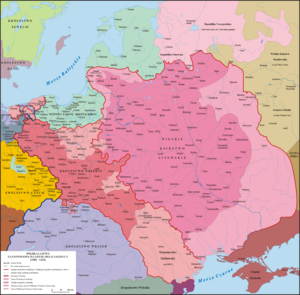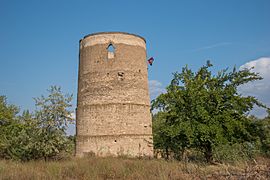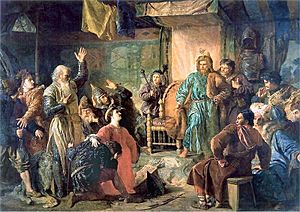Vytautas facts for kids
Quick facts for kids Vytautas the Great |
|
|---|---|
| Duke of Trakai | |
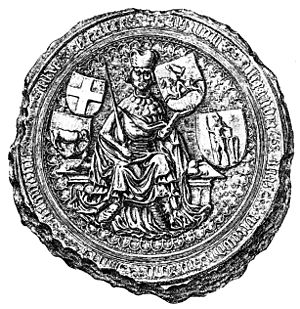
Seal of Vytautas
|
|
| Grand Duke of Lithuania | |
| Reign | 4 August 1392 – 27 October 1430 |
| Predecessor | |
| Successor | Švitrigaila |
| Born | c. 1350 Senieji Trakai, Grand Duchy of Lithuania |
| Died | 27 October 1430 (aged 79–80) Trakai, Grand Duchy of Lithuania |
| Burial | Vilnius Cathedral, Vilnius |
| Spouse |
|
| Issue | Sophia |
| House | Kęstutis |
| Father | Kęstutis |
| Mother | Birutė |
Vytautas (around 1350 – 27 October 1430) was a very important ruler of the Grand Duchy of Lithuania. He is also known as Vytautas the Great. He was also the Prince of Grodno and Lutsk for some time.
In modern Lithuania, Vytautas is seen as a national hero. He played a big part in the country's national rebirth in the 1800s. Vytautas is still a popular boy's name in Lithuania. A university, Vytautas Magnus University, was named after him 500 years after his death. Many statues of him were built in independent Lithuania between 1918 and 1939. Vytautas spoke the Lithuanian language with Jogaila, who became King of Poland.
Contents
Struggle for Power
Early Conflicts (1377–1384)
Vytautas's uncle, Algirdas, was the Grand Duke of Lithuania until he died in 1377. Algirdas and Vytautas's father, Kęstutis, ruled together. Algirdas managed the eastern parts, while Kęstutis protected the western borders from the Teutonic Knights.
After Algirdas died, his son Jogaila became Grand Duke. This started a fight for power. In 1380, Jogaila secretly made a deal with the Teutonic Knights against Kęstutis. When Kęstutis found out in 1381, he took over Vilnius and put Jogaila in prison, making himself Grand Duke.
But Jogaila escaped and gathered an army. Kęstutis and Vytautas were arrested and taken to Kreva Castle. A week later, Kęstutis was found dead. It's still debated whether he died naturally or was killed.
In 1382, Vytautas escaped from Kreva. He asked the Teutonic Order for help. Jogaila and the Order had made a deal, but it fell apart, and war started again in 1383. Vytautas became a Catholic and was named Wigand. He fought alongside the Order against Jogaila. In 1384, Vytautas promised to give some land to the Teutonic Order if they recognized him as Grand Duke. However, in July 1384, Vytautas changed his mind and made peace with Jogaila. He then burned three important Teutonic castles and got back all of Kęstutis's lands, except for Trakai.
Later Conflicts (1385–1392)
In 1385, Jogaila made an agreement with Poland called the Union of Krewo. He married Jadwiga of Poland and became King of Poland, known as Władysław II Jagiełło. Vytautas was part of this agreement and was baptized again as a Catholic, receiving the name Alexander. In 1386, Vytautas showed respect to Jogaila after he became king.
Jogaila left his brother Skirgaila in charge of Lithuania. But Skirgaila was not popular. Vytautas saw this as a chance to become Grand Duke himself. In 1389, he attacked Vilnius but didn't succeed. In 1390, Vytautas again allied with the Teutonic Order. He promised to give them more land. His army then invaded Lithuania. To gain more power, Vytautas married his only daughter, Sophia, to Vasili I of Russia in 1391.
The Polish nobles were unhappy that their king, Jogaila, spent too much time on Lithuanian matters. It was clear the war could go on for years. In 1392, Jogaila offered Vytautas the role of regent instead of Skirgaila. Vytautas accepted and broke his alliance with the Teutonic Order again. He burned three Teutonic castles and returned to Vilnius. Jogaila and Vytautas signed the Astrava Treaty. Vytautas got back all of Kęstutis's lands, including Trakai, and was given more power. Vytautas would rule Lithuania in Jogaila's name. After Vytautas died, all his lands and powers would go back to Jogaila.
Grand Duke of Lithuania
Expanding Eastward
Vytautas wanted to control as much land as possible in the east, following Algirdas's goals. Much of this land was already part of the Grand Duchy, but some was controlled by the Mongols. Tokhtamysh, the leader of the Golden Horde, asked Vytautas for help in 1395 after he lost his throne. They agreed that Vytautas would help Tokhtamysh regain power, and in return, the Golden Horde would give more land to Lithuania.
In 1398, Vytautas's army attacked part of the Crimea and built a castle there. This meant Lithuania now stretched from the Baltic Sea to the Black Sea. Many Tatar captives were brought to Lithuania.
Poland still tried to control Lithuania. This led Vytautas to ally with the Teutonic Order for a third time. In October 1398, by the Treaty of Salynas, Vytautas gave his home region, Samogitia, to the knights. He also made an alliance with them to conquer and divide Pskov and Novgorod the Great.
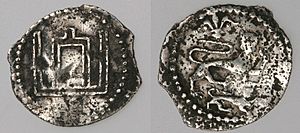
Vytautas and Jogaila got support from Pope Boniface IX to start a crusade against the Mongols. This showed that Lithuania was now fully Christian and could defend its faith, meaning the Teutonic Knights had no reason to attack Lithuania anymore. However, this campaign ended in a big defeat at the Battle of the Vorskla River in 1399. Many princes died, and Vytautas barely escaped. This was a big shock for Lithuania and Poland. Some areas rebelled against Vytautas. Smolensk was taken back by its ruler, and Lithuanians didn't get it back until 1404.
Vytautas fought a war from 1406 to 1408 against his son-in-law Vasili I of Moscow and Švitrigaila, Jogaila's brother. The war with Moscow ended in 1408.
Wars Against the Teutonic Order
"We do not know why this decision was made, or how we have offended Your Lordship so much that you have turned against us. First, you made a decision about the land of Samogitia, which is our inheritance and our homeland from our ancestors. We still own it, it is and has always been the same Lithuanian land, because there is one language and the same people. But because the land of Samogitia is lower than the land of Lithuania, it is called Samogitia, which in Lithuanian means 'lower land' [ Žemaitija ]. And the Samogitians call Lithuania Aukštaitija, which means 'higher land' from their point of view. Also, the people of Samogitia have long called themselves Lithuanians and never Samogitians, and because of this identity we do not write about Samogitia in our letter, because everything is one: one country and the same people."
In the Treaty of Salynas, Vytautas had given Samogitia to the Teutonic Knights. Samogitia was very important to the Order because it connected their lands in Prussia with the Livonian Order in Latvia. The two orders wanted to join forces. However, the knights only ruled Samogitia for three years. On 13 March 1401, the Samogitians, with Vytautas's help, rebelled and burned two castles. The knights got help from Švitrigaila, Jogaila's brother, who wanted Vytautas's title.
In 1404, the Peace of Raciąż was signed. This treaty mostly repeated the Treaty of Salynas: Samogitia went back to the Teutonic Knights. Poland promised not to help Lithuania if another war started. The knights promised to help Vytautas in the east. But the treaty didn't solve the problems, and everyone got ready for war.
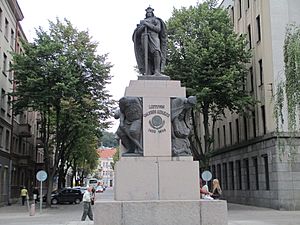
In 1408, Vytautas made peace in the east and focused on Samogitia again. In 1409, the second Samogitian uprising against the Teutonic Knights began. Rebels burned Skirsnemunė castle. Both Poland and Lithuania supported the rebels. Vytautas gathered a large army from 18 lands he controlled. This army joined Polish forces and marched towards the Teutonic headquarters at Marienburg (now Malbork).
In 1410, Vytautas himself led the Grand Duchy's forces in the famous Battle of Grunwald. The battle ended in a huge victory for Poland and Lithuania. Even though they didn't capture Marienburg, the Teutonic Knights never fully recovered their strength. From then on, they were less of a threat to Poland-Lithuania. Poland-Lithuania became known as a great power in Europe, and Vytautas gained much respect.
As a result of the Peace of Thorn of 1411, Vytautas received Samogitia for his lifetime. But the two sides couldn't agree on the exact border. Sigismund, Holy Roman Emperor, helped to settle the disagreement. In 1413, it was decided that the whole right bank of the Nemunas (Neman River) belonged to Samogitia and therefore to Lithuania. The Teutonic Knights disagreed, and a new war started in 1414. This war lasted only a few months, and the dispute was taken to the Council of Constance. Even though the problem wasn't fully solved, the Samogitians got to present their case to European leaders. This was an important moment in Lithuania's history of diplomacy.
Several other attempts to settle the dispute failed, and another war with the Teutonic Order began in 1422. After a few months of fighting, the Treaty of Lake Melno was signed. Samogitia was given to Lithuania forever, while the city of Memel (now Klaipėda) and nearby areas stayed with the Order. This border remained stable for about 500 years. With peace established, Vytautas could focus on improving his state and his relationship with Poland.
Relationship with Poland
In 1399, Jadwiga of Poland and her newborn baby died during childbirth. Jogaila's power in Poland was at risk because he was a foreign king with no other claim to the throne except his wife. Also, the defeat at Vorskla made Poland and Lithuania rethink their relationship. This led to the Union of Vilnius and Radom in 1401. Vytautas was given a lot of freedom to rule, but after his death, the title and powers of Grand Duke of Lithuania would go to the King of Poland. If Jogaila died first without an heir, the Polish nobles agreed not to choose a new king without asking Vytautas. A special part of this union was that the Lithuanian nobles presented their own document. This was the first time people other than dukes played a role in state matters.

Vytautas also helped create the Union of Horodło with Poland in 1413. This agreement said that the Grand Duchy of Lithuania would keep its own Grand Duke and its own parliament. At the same time, both the Polish and Lithuanian parliaments would discuss all important matters together. This union was important for culture and politics. It gave Lithuanian Christian nobles the same rights as Polish nobles. This helped Polish and Lithuanian nobles work together more.
In January 1429, at a meeting in Lutsk, Sigismund, King of Hungary, suggested that Vytautas should be crowned King of Lithuania. This caused a big problem between Vytautas, King Władysław, and the Polish nobles. The messengers carrying documents supporting Vytautas's crowning were stopped at the Polish-Lithuanian border in the autumn of 1430. Vytautas died in the Trakai Island Castle, ending the whole plan. He was buried in the Cathedral of Vilnius, but his remains are now lost.
According to the Encyclopædia Britannica, Vytautas "was certainly the most imposing personality of his day in Eastern Europe, and his martial valour was combined with statesmanlike foresight." This means he was a very powerful and smart leader.
Reforms and Changes
Vytautas helped his state's economy grow and made many changes. Under his rule, the Grand Duchy of Lithuania became more organized. Local princes, who were related to the royal family, were replaced by governors loyal to Vytautas. These governors were rich landowners who became the foundation of the Lithuanian nobility. During Vytautas's rule, important families like the Radvila (Radziwiłł) and Goštautas families started to become powerful.
In 1398, Vytautas brought families of the Karaim (388 families) and Tatar peoples to Lithuania. Their main job was to guard castles and bridges. They also worked as translators, farmers, traders, and diplomats. Vytautas is still highly respected by these groups. The 500-year anniversary of his death was celebrated in 1930 in the Karaim temple in Vilnius.
Family Life
Vytautas was born around 1350 in the castle of Old Trakai (Senieji Trakai). He was the son of Kęstutis and his wife Birutė. Vytautas was a cousin and childhood friend of Jogaila (Władysław II Jagiełło), who became King of Poland in 1386.
Around 1370, Vytautas married Anna. They had one daughter, Sophia of Lithuania. Sophia married Vasily I, the Grand Prince of Moscow, and later became regent for their son Vasili II. After Anna died in 1418, Vytautas married her niece, Juliana Olshanska. Because the two women were related, the Bishop of Vilnius didn't want to perform the wedding without special permission from the Pope. However, another bishop married them on 13 November 1418.
In Popular Culture
A statue of Vytautas is part of the Millennium of Russia monument in Veliky Novgorod.
Vytautas appears in several stories about the conflict between Poland-Lithuania and the Teutonic Order. He is in the poem Konrad Wallenrod by Adam Mickiewicz. He was played by Józef Kostecki in the 1960 movie Knights of the Teutonic Order, based on the famous novel by Henryk Sienkiewicz.
In 2014, a short cartoon was made about the Karaim story of Vytautas and his magic horse. It had voiceovers in several languages, including Karaim, Polish, English, and Lithuanian.
In the video game Age of Empires II: Definitive Edition, Vytautas is a cavalry hero.
Vytautas is also mentioned in Jonathan Franzen's novel "The Corrections", which says his death in 1430 led to Lithuania's slow decline as a "global player."
See also
 In Spanish: Vitautas para niños
In Spanish: Vitautas para niños
- Gediminids
- House of Kęstutis – family tree of Vytautas
- Order of Vytautas the Great


